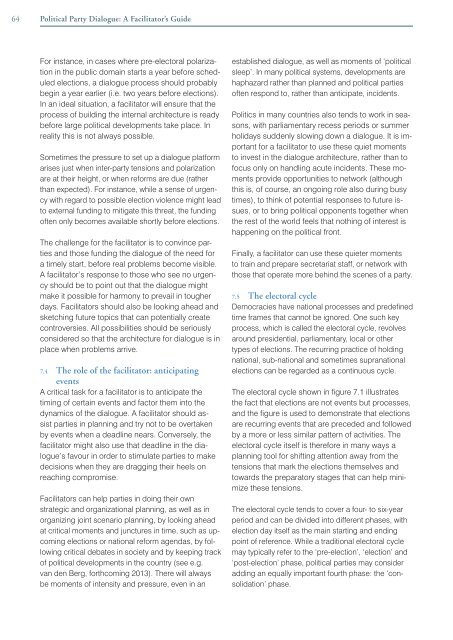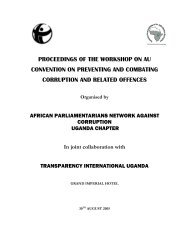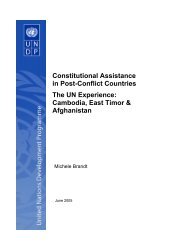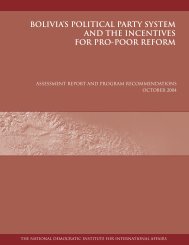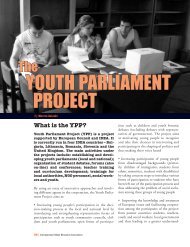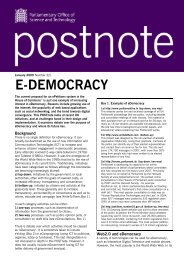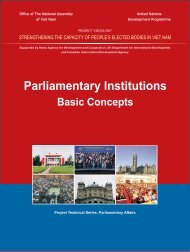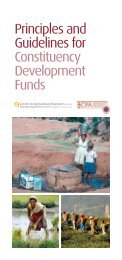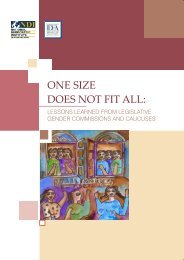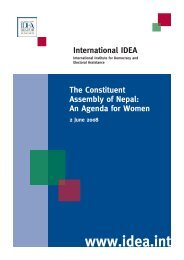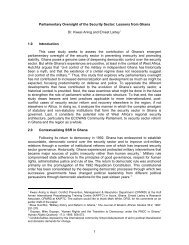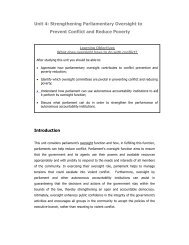Political Party Dialogue â A facilitators guide
Political Party Dialogue â A facilitators guide
Political Party Dialogue â A facilitators guide
You also want an ePaper? Increase the reach of your titles
YUMPU automatically turns print PDFs into web optimized ePapers that Google loves.
64 <strong>Political</strong> <strong>Party</strong> <strong>Dialogue</strong>: A Facilitator’s GuideFor instance, in cases where pre-electoral polarizationin the public domain starts a year before scheduledelections, a dialogue process should probablybegin a year earlier (i.e. two years before elections).In an ideal situation, a facilitator will ensure that theprocess of building the internal architecture is readybefore large political developments take place. Inreality this is not always possible.Sometimes the pressure to set up a dialogue platformarises just when inter-party tensions and polarizationare at their height, or when reforms are due (ratherthan expected). For instance, while a sense of urgencywith regard to possible election violence might leadto external funding to mitigate this threat, the fundingoften only becomes available shortly before elections.The challenge for the facilitator is to convince partiesand those funding the dialogue of the need fora timely start, before real problems become visible.A facilitator’s response to those who see no urgencyshould be to point out that the dialogue mightmake it possible for harmony to prevail in tougherdays. Facilitators should also be looking ahead andsketching future topics that can potentially createcontroversies. All possibilities should be seriouslyconsidered so that the architecture for dialogue is inplace when problems arrive.7.4 The role of the facilitator: anticipatingeventsA critical task for a facilitator is to anticipate thetiming of certain events and factor them into thedynamics of the dialogue. A facilitator should assistparties in planning and try not to be overtakenby events when a deadline nears. Conversely, thefacilitator might also use that deadline in the dialogue’sfavour in order to stimulate parties to makedecisions when they are dragging their heels onreaching compromise.Facilitators can help parties in doing their ownstrategic and organizational planning, as well as inorganizing joint scenario planning, by looking aheadat critical moments and junctures in time, such as upcomingelections or national reform agendas, by followingcritical debates in society and by keeping trackof political developments in the country (see e.g.van den Berg, forthcoming 2013). There will alwaysbe moments of intensity and pressure, even in anestablished dialogue, as well as moments of ‘politicalsleep’. In many political systems, developments arehaphazard rather than planned and political partiesoften respond to, rather than anticipate, incidents.Politics in many countries also tends to work in seasons,with parliamentary recess periods or summerholidays suddenly slowing down a dialogue. It is importantfor a facilitator to use these quiet momentsto invest in the dialogue architecture, rather than tofocus only on handling acute incidents. These momentsprovide opportunities to network (althoughthis is, of course, an ongoing role also during busytimes), to think of potential responses to future issues,or to bring political opponents together whenthe rest of the world feels that nothing of interest ishappening on the political front.Finally, a facilitator can use these quieter momentsto train and prepare secretariat staff, or network withthose that operate more behind the scenes of a party.7.5 The electoral cycleDemocracies have national processes and predefinedtime frames that cannot be ignored. One such keyprocess, which is called the electoral cycle, revolvesaround presidential, parliamentary, local or othertypes of elections. The recurring practice of holdingnational, sub-national and sometimes supranationalelections can be regarded as a continuous cycle.The electoral cycle shown in figure 7.1 illustratesthe fact that elections are not events but processes,and the figure is used to demonstrate that electionsare recurring events that are preceded and followedby a more or less similar pattern of activities. Theelectoral cycle itself is therefore in many ways aplanning tool for shifting attention away from thetensions that mark the elections themselves andtowards the preparatory stages that can help minimizethese tensions.The electoral cycle tends to cover a four- to six-yearperiod and can be divided into different phases, withelection day itself as the main starting and endingpoint of reference. While a traditional electoral cyclemay typically refer to the ‘pre-election’, ‘election’ and‘post-election’ phase, political parties may consideradding an equally important fourth phase: the ‘consolidation’phase.


